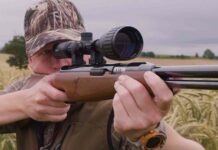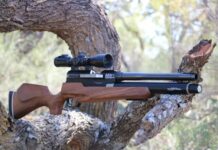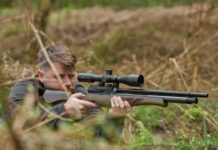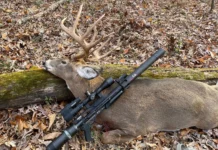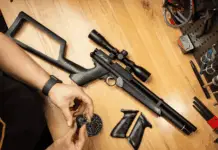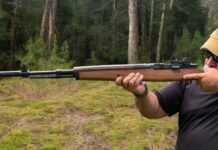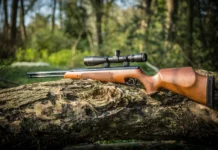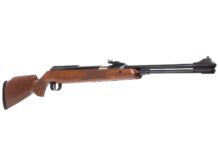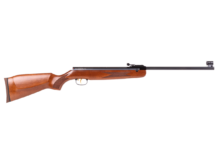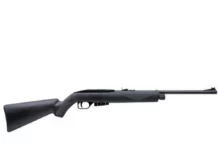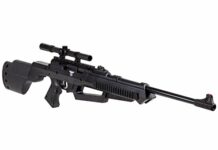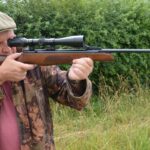

The Winchester Model 70 XTR Featherweight is a bolt-action rifle that was introduced by Winchester in 1981. The beautiful classic stock sets it apart from other Winchester Model 70 rifles. It is a beautiful and lightweight rifle that has become quite collectable.
One of the key features of the Winchester Model 70 XTR Featherweight is its lightweight design. It weighs in at under 7 pounds, which makes it one of the lightest rifles in its class. This makes it easy to carry and maneuver in the field, and it can be especially useful for hunters who need to hike long distances to reach their hunting spot. The lightweight design also helps to reduce fatigue when shooting for extended periods of time, making it a good choice for long-range shooting or for those who may be sensitive to recoil.
Table of Contents
Our Amazon Affiliate Links for Winchester Model 70 Featherweight
Leupold Scopes like seen in video Scope Bases for Winchester M70Leupold Scope Mounts & Bases for M70

In addition to its lightweight design, the Model 70 XTR Featherweight is also known for its accuracy and reliability. The XTR did not have controlled-round feed bolt as the newer Featherweights have, but it still had smooth and consistent feeding of rounds, accuracy and reliability. The barrel is also free-floated, which helps to improve accuracy by eliminating pressure points that can cause the barrel to flex.
The Winchester Model 70 XTR Featherweight was chambered in a variety of calibers, including .257 Roberts, 280 Remington, .243 Winchester, .270 Winchester, and .30-06 Springfield. This allowed shooters to choose the caliber that best meets their needs and preferences.
One potential downside of the Winchester Model 70 XTR Featherweight is its price. The XTR is no longer manufactured and has become hard to find, driving up the price if you can find one one the used market. It is generally more expensive than some other rifles in its class, which may be a concern for those who are on a tight budget. However, many shooters feel that the increased cost is worth it due to the rifle’s beauty, accuracy, reliability, and lightweight design.
In conclusion, the Winchester Model 70 XTR Featherweight is a classic bolt-action rifle that has gained a loyal following among shooters due to its accuracy, reliability, and lightweight design. It is a good choice for hunters who need a rifle that is easy to carry and flat shooting. While it may be harder to find and more expensive than some other rifles in its class, many shooters feel that the increased cost is worth it due to the rifle’s exceptional performance and durability. So, if you are in the market for a beautiful and reliable bolt-action rifle, the Winchester Model 70 XTR Featherweight is definitely worth the hunt.

Reference Books for Winchester M70 Rifle

Shooting Times December 1979: Winchester’s New M70

The Rifleman’s Rifle: Winchester’s Model 70 by Roger G. Rule $39 at AMAZON
Roger Rule’s book on the Winchester Model 70 is a fact-filled reference guide that every Winchester M70 collector and shooter needs. It is filled with detailed information and facts about the “Rifleman’s Rifle”. Order in paperback and you will not be disappointed with the tremendous volume of facts and data.

The Winchester Model 70 Performance Tuning Manual by David Watson $17 at AMAZON
Gunsmithing tips for modifying your Winchester Model 70
- History of how the rifle came about!
- How to purchase and what to look for in a Winchester Model 70!
- Correct cleaning, maintenance and testing! Stocks, bedding, modifications and after market parts!
- Barrel, bolt and action modifications and tuning!
- How to perform trigger jobs and replacement performance triggers
- Iron sights, optics, after market items and zeroing!
- How to choose the right ammunition or hand load for this classic rifle!
- Specialised shooting techniques suited to this classic rifle!
- Trouble shooting for your Winchester Model 70!
- Special gunsmith techniques and tips to squeeze the most out of your Winchester Model 70!
This book helps the reader to purchase, clean, restore, tune, modify and compete with this wonderful piece of living history – all at home.
This book unlocks the gunsmithing secrets and special techniques of how to get the most out of this rifle. This book is for the average shooter who wishes to hunt with something classical or surplus, for the sportsman who wishes to compete in historical military service rifle competition, for the collector and enthusiast who simply wants to enjoy the nostalgia and wants to put other shooters to shame!
This book provides the reader with step by step instructions and detailed photographs on how to modify and tune their rifle for standard competition, as well as ‘no holds barred’ modifications for absolute accuracy.
Winchester Model 70; Before & After The M70 XTR
The development of the Winchester Model 70 rifle is a fascinating journey that spans several decades, starting from its inception in the early 20th century. The rifle went through various iterations and improvements, cementing its place as one of the most iconic and revered bolt-action rifles in firearms history. Let’s explore the key milestones in the development of this legendary firearm:
Origins (Early 1900s): The story of the Model 70 begins in the early 20th century when Winchester Repeating Arms Company sought to create a bolt-action rifle that would cater to the needs of serious hunters and sportsmen. The goal was to design a rifle that offered exceptional accuracy, reliability, and craftsmanship, setting a new standard for hunting rifles.
Model 54: The predecessor to the Model 70 was the Winchester Model 54, introduced in 1925. The Model 54 was designed by the renowned firearms engineer T.C. Johnson, who would later play a crucial role in the development of the Model 70. The Model 54 was a bolt-action rifle that was well-regarded for its accuracy and quality.
Design and Improvements: Building upon the success of the Model 54, Winchester set out to create a rifle that would incorporate further refinements and enhancements. After T.C. Johnson’s death in 1934, Edwin Pugsley led the team of engineers responsible for these improvements, seeking to address certain design issues and make the rifle even more accurate and reliable.
Model 70 Introduction (1936): The Winchester Model 70 was officially introduced to the market in 1936. It was originally offered in the .30-06 Springfield cartridge, which was a popular choice for hunters at the time. From the outset, the Model 70 was met with enthusiasm from hunters and shooters who recognized its superior performance and craftsmanship.
Controlled Round Feed (CRF): One of the key innovations in the Model 70 was the incorporation of a Controlled Round Feed (CRF) action. CRF is a feature that ensures the cartridge is securely controlled as it moves from the magazine into the chamber, enhancing reliability and smooth feeding. This was one of the defining characteristics of pre-’64 Model 70 rifles.
Three-Position Safety: Another significant improvement in the Model 70 was the addition of a three-position safety. This safety allowed shooters to work the bolt with the safety engaged, offering a “locked” position, a “load/unload” position, and a “fire” position. This feature added to the rifle’s safety and versatility.
World War II Service: During World War II, the U.S. government recognized the excellence of the Model 70 and acquired considerable numbers for military use. The “U.S. Model 1941” Winchester rifles served as sniper rifles, demonstrating their accuracy and effectiveness in combat.
Post-’64 Changes: In 1964, Winchester implemented some changes to reduce production costs, leading to the post-’64 versions of the Model 70. These changes included a push-feed action instead of the original CRF and a redesigned safety. While the post-’64 rifles were more affordable to manufacture, some collectors and enthusiasts consider the pre-’64 versions to be of higher quality and craftsmanship.
The Classic Model 70: In response to demand from hunters and collectors for the pre-’64 features, Winchester reintroduced the Model 70 with classic features in 1992. This iteration, known as the Classic Model 70, brought back the CRF action and the three-position safety, rekindling the love for this classic rifle.
Continuing Evolution: Over the years, the Model 70 continued to evolve with various improvements, including chambering options in numerous calibers and custom features catering to specific shooting preferences. Today, the Model 70 is manufactured by FN America, LLC, maintaining its reputation for accuracy, reliability, and craftsmanship.
From its inception in the early 20th century to its current iterations, the Model 70 remains a symbol of excellence in the world of bolt-action rifles, earning a special place in the hearts of hunters, shooters, and collectors alike.
See our Winchester M70 XTR Featherweight Video Review
Leupold VX-5HD 3-15×44 Firedot Rifle Scope ReviewBest Rain Gear For Hunting & Fishing 2024Lights For Night HuntingBest AR15 Scopes Under $200Tikka T1X 17HMR ReviewRemington Mountain Rifle 280 RemingtonBest Broadheads For Deer Hunting 2024Polaris Ranger 570 Midsize Review
